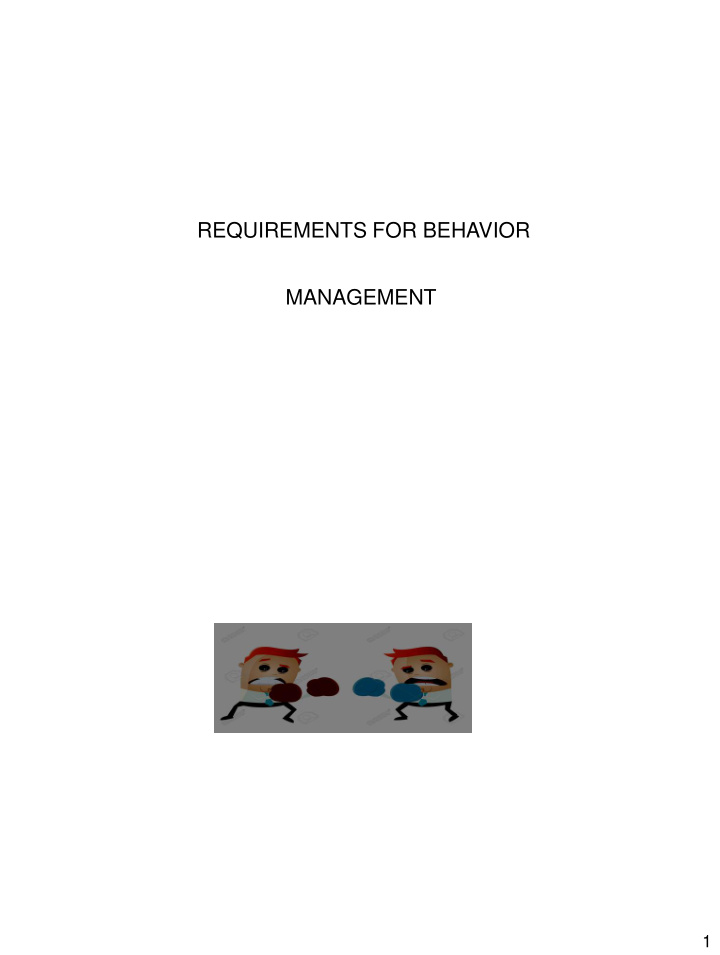



REQUIREMENTS FOR BEHAVIOR MANAGEMENT 1
The facility must identify and evaluate behavioral symptoms that are distressing to the resident or infringe on other residents’ rights. The first of the requirements is to conduct... Evaluations for Behavior Management, which are required to include: * Identification if the resident behavior is transitory or permanent * Review of the resident's previous behaviors and activities * Review of baseline data including intensity, duration and frequency of the resident behavior 2
* Identification of recent changes in the resident's life, such as death in the family, change in daily routine, or changes in the Resident's Negotiated Service Agreement * Identification of environmental causes that could contribute to the resident's behavior such as excessive heat, noise, overcrowding, hunger, staffing * Rule out possible medical causes such as pain, constipation, fever, infection or medication side effects * Identification of events that trigger behavioral symptoms 3
The second requirement is to develop... Interventions The facility must develop an intervention for each behavioral symptom * All staff must be aware of and consistently implement each behavioral symptom * The intervention needs to be the least restrictive * Each intervention needs to be reviewed within (72) hours of implementation, and from then on as appropriate, to evaluate the continued need for the intervention 4
The third requirement for the Prescribing Provider The resident's medication regimen must be evaluated every (6) months to assure that medications used to treat behavioral symptoms are necessary and at the lowest possible dose REQUIREMENTS FOR THE NEGOTIATED SERVICE AGREEMENT. The Negotiated Service Agreement must be completed and signed no later than fourteen (14) calendar days from the date of admission. A written interim plan must be developed and used while the Negotiated Service Agreement is Psychotropic or behavior modifying medications must be prescribed by a physician or authorized The facility will monitor the resident to determine continued need for the medication based on the resident’s demonstrated behaviors 5
• The facility will monitor the resident for any side effects that could impact the resident’s health and * The use of psychotropic or behavior modifying medications must be reviewed by the physician or authorized provider at least every six (6) months. * The facility must provide behavior updates to the physician or authorized provider to help facilitate an informed decision on the continuing use of the psychotropic or behavior modifying medication. 6
How can we do all of that....? Start at the beginning http://healthandwelfare.idaho.gov/Portals/0/Medical/LicensingCertification/RALFBMPFlowChart.pdf 7
Once you have determined the need for a Behavior Plan it may help to develop a checklist which includes all the required areas for assessment, for example: * Could this behavior be a result of illness, pain or other medical cause? * Is the behavior temporary or permanent? * Is this a new behavior? * What circumstances trigger the behavior? Etc. until all areas required are assessed Include everyone in the fact finding Staff Family Residents 8
Based on the results of the assessment initial Interventions can be developed. Once again, involve as many participants as possible in determining what interventions appear to be effective in preventing, decreasing the intensity or limiting the duration of the behavior. Be prepared to review and amend the interventions as required within 72 hours and ongoing. The behaviors must be documented ongoing. All staff must be familiar with what behaviors have been identified and what interventions should be implemented for prevention or in response to them. Clear, concise identification of both the distressing behaviors and the interventions is important to obtain accurate information on the effectiveness of your efforts. 9
Poor example: Joe has signs of anxiety. Better example : Joe experiences anxiety by pacing, crying and wringing his hands. Poor example: Reassure Joe when he is anxious. Better example : Provide Joe with quiet time in his room. http://healthandwelfare.idaho.gov/Portals/0/Medical/LicensingCertification/RALFBehaviorDataSheet1.pdf 10
For more detailed information and training on Behavior Management Go to “Training Resources L&C online courses Behavior Management” at... http://healthandwelfare.idaho.gov/Providers/Providers-Facilities/State 11
Recommend
More recommend